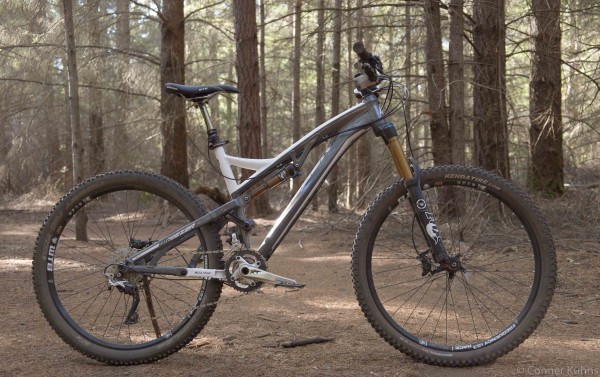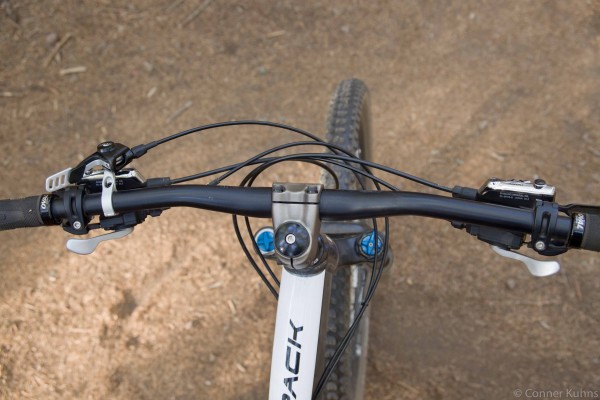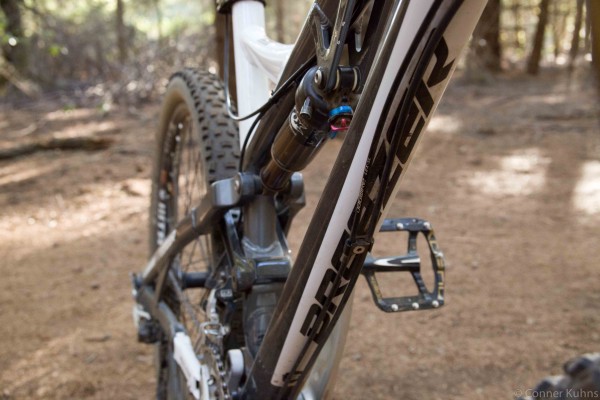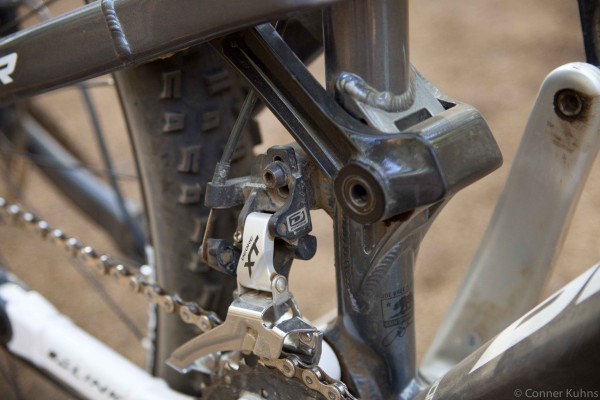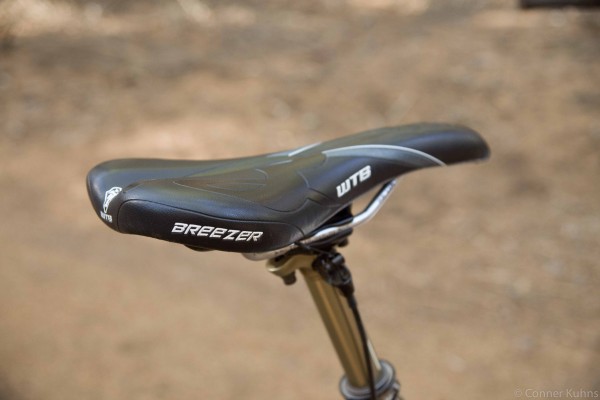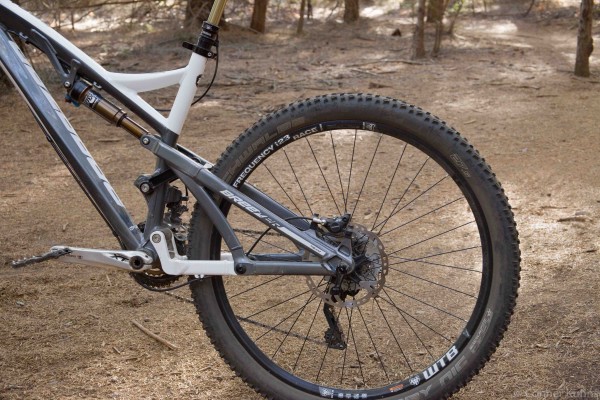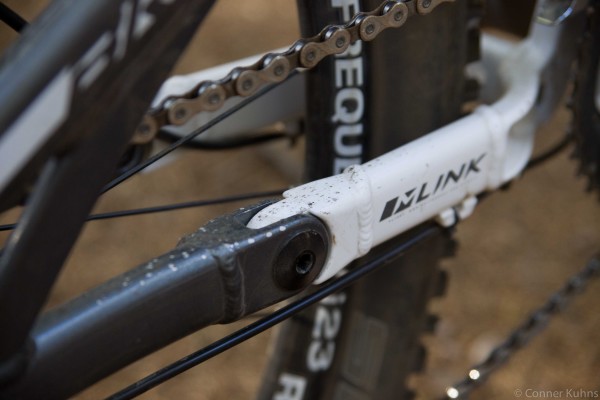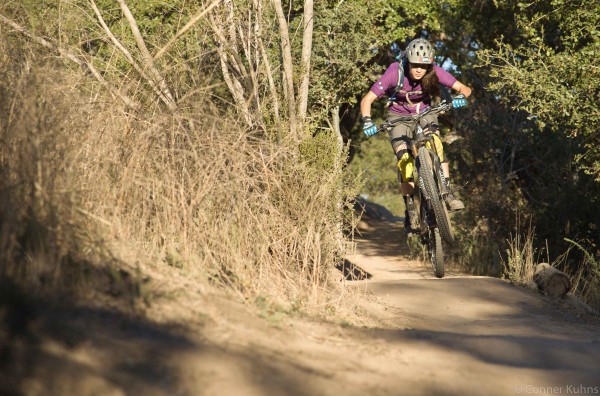With a bold two tone paint job, clean lines, and an innovative new suspension, the all new Breezer Repack is an interesting entrant in the 650B all mountain segment. With over two years of development behind it and geometry input from legendary frame builder Joe Breeze, we couldn’t say no when we were offered a long term review unit after our first ride experience in Bootleg Canyon.
We’ve had several test riders shredding on the Breezer for almost three months, so hop past the break to see how it fared…
ACTUAL WEIGHT
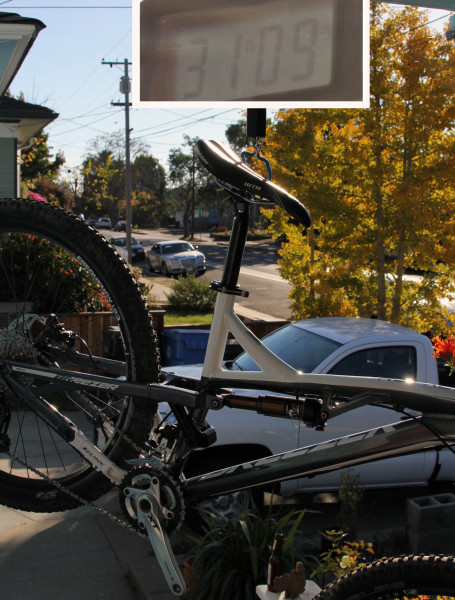
According to the Breezer website, the Repack is spec’d stock with aggressive 2.3″ WTB Vigilantes. Those tires in their lightest trim weigh 790 grams. Our bike came spec’d with much lighter (and drift happy) Nobby Nic tires. Depending on the compound, the 27.5 version of those Schwalbe tires can easily be half a pound lighter than the OEM tires that are normally spec’d.
The microsite for the Breezer Repack incorrectly lists the OEM spec for the tires as being WTB Vigilantes. The bike will be rolling off dealer floors with Nobby Nic tires.
DETAILS
Up front, the Breezer Repack Team comes equipped stock with a 2×10 Shimano XT drivetrain, a 70mm Ritchey WCS stem paired with a 740mm bar, and no dropper post. While we felt the bars were a nice healthy width, we did swap to a shorter 50mm stem because the 24″ (615mm) top tube length of the Medium frame felt long for our ~5’8 test riders with the stock stem length.
Routing along the frame is clean and simple, although some in rocky areas might take issue with the downtube routing. There is no provision for stealth routing for dropper posts this year, but it’s in the works for the next model year. In the mean time, the front derailleur stop on the top tube makes a nice anchor point for the external routing on the Fox D.O.S.S. dropper post we installed , which we reviewed here.
Breezer does not currently offer an XX1 or X01 buildkit, so each of the thee different build kits comes stock with a direct mount Shimano front derailleur.
One place where the Breezer kit outshines bikes several times it’s cost is with the saddle – the custom Ti/Cro WTB Volt is incredibly comfortable – even on long distance riders. The one place we have to ding the Repack? The seatpost. At an MSRP of $4,400, we think a dropper post should be standard fare.
According to Product Manager J.T.Burke though, it was a conscientious decision to not spec a dropper, as they found that over half of consumers buying all mountain bikes equipped with dropper posts ended up replacing the stock component for their preferred product. So the company choose to save consumers $300-400 upfront, and allow them to install their favorite dropper, without having to deal with the latter hassle of selling their old one, etc..
We have covered the M-Link design in great detail before, but the short and skinny is that the M-Link is claimed to blend the best of dual short link (VPP, DW-Link, etc…) and FSR style designs by placing the pivot in the middle of the chainstay. This puts less load on the bearings than short link designs and offers more rear triangle stiffness than the interrupted seat says found on Horst link bikes.
The design team originally developed this bike around 150mm of travel but found that it was so efficient uphill, that they bummed up the travel to 160mm without noticing a negative impact on climbing or handling. As J.T. put it, “f you could have a seven or even eight inch travel bike that climbs and handles like your trail bike, wouldn’t you want that?”
Despite adjusting the clutch on the Shimano Shadow Plus Derailleur, there was still some noticeable chain slap developing on the drive side chainstay after only a few rides. We would like to see future versions equipped with some sort of chain stay protector off the showroom floor.
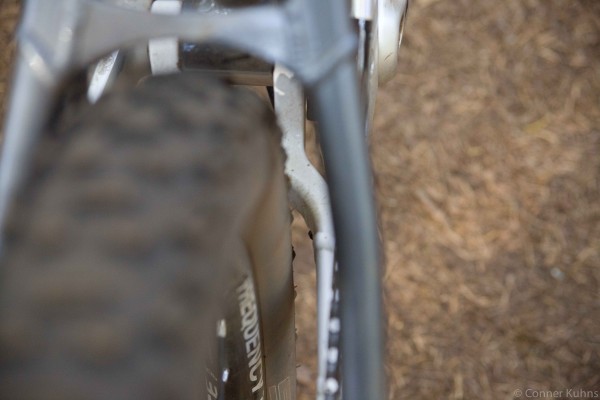
The stock build calls for aggressive WTB Vigilante tires, but as previously mentioned, our demo bike came equipped with XC tires. During the course of testing, we swapped out the Nobby Nics for the new Kenda Nevegal X Pro tires, and later the WTB Vigilante.
LONG TERM MAINTENANCE
With big pivots and sealed cartridge bearings throughout, the sight of the Repack won’t give service mechanics cause to scatter. Everyone on the design team at Breezer spent some time as a professional mechanic and it shows. An expanding collett system similar to the one employed by Santa Cruz Bikes keeps everything tight, and a hollow 17mm thru axle hardware helps to keep weight down. We didn’t do a full tear down, but did notice that two pivots located where the rear triangle and linkage meet might prove difficult to access.
Despite three months of hard riding, we haven’t experienced any annoying creaks or squeaks, and the full Shimano XT group has been flawless. Aside from the post and stem, this bike is ready to rock right out of the box.
ON THE TRAIL
The first thing you notice about the Breezer is it’s size. Stand over isn’t bad, although the frame feels tall when seated, but the fit runs large. The sizing is closer to what you’d expect from a boutique manufacturer from Colorado than your average big box brand. Switching out the stock 70mm stem to a shorter 50mm unit made a big difference in handling.
The Breezer is an incredible dance partner when pointed uphill. The mid-chainstay pivot bridges the gap between horst link and dual short link suspension platforms, but the bike pedals decidedly more like it’s ultra efficient VPP/DW-Link cousins. It’s so good that the shock has been tuned so that the climb mode offers only a minimal amount of extra compression in the climb mode. This eliminates the risk of rallying down a trail while accidentally locked out, but also provides just enough compression adjustment to tune the ride for descents.
Acceleration is fast and efficient both in and out of the saddle and the geometry keeps you centrally weighted. So cleaning technical pitches aboard the Repack is a matter of point, shoot, and tractor. The only downside is the bike’s weight, which is noticeable on long grinds. We were fooled more than once into racing up the hill by the bikes sprightly pedaling performance, only to be caught off guard at the top by how tired our legs felt. The Repack with slippery light cross country shoes and a regular seat post was over 31 lbs. After we shod the 6″ bike properly in more aggressive rubber, installed a dropper post and pedals, it was within a few pounds of the weight of a modern downhill bike.
For many though (myself included), weight isn’t as important as having fun, and this is where the equation gets interesting. While the current crop of ultra-slack bikes make it clear what sacrifices you’ll make pedaling up the trail, the cost-benefit analysis of the Repack is more subtle. With it’s steep front end, the Breezer doesn’t handle like the light weight downhill bike the travel and weight would suggest. Rather it performs like a long legged XC bike, it’s capable, but does not inspire the same bravado downhill as some of the slacker bikes in the same category. It was stable in the air but felt planted, and the front end came off the ground easily, but the bike required a good amount of body English to pop off lips. Steering was twitchy at low speeds due to the steep front end and we saw one test rider tuck the front end accidentally while pumping flat corners. But, the bike shone when ripping on the undulating miles of natural single track that crisscross the Santa Cruz Mountains and Marin Headlands.
Breezer’s first foray into the world of modern full suspension bikes is unique in a crowded marketplace because it offers a ride dynamic unlike any other at this travel. The steeper geometry won’t win any fans in the trendy endurobro crowd, but might just be the ticket for a cross country oriented rider looking to push their limits downhill. The responsive new suspension platform works remarkably well, and we look forward to it being translated to both smaller travel and carbon iterations.
Special thanks to Breezer for letting us review the bike. For more information on the product, check their website.
Photo Credit: © Conner Kuhns
